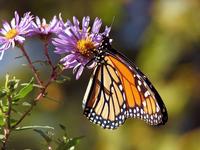Tara Cornelisse, Center for Biological Diversity
On March 1, 2021, the Center for Biological Diversity filed a petition to seek Endangered Species Act protection for the Sacramento Mountains checkerspot butterflies. This species is only known to exist in a limited area within the Lincoln National Forest in southern New Mexico. Since 1999, the Sacramento Mountains checkerspot butterfly population has been declining precipitously. This situation had led the Forest Service to conclude that it is the most endangered butterfly in the . . .
READ MORE
Answer: It is a Dead Leaf Butterfly. This butterfly exhibits a truly remarkable example of camouflage that has evolved over time. When this butterfly’s wings are closed, it resembles a dried-up leaf and when the wings are opened a spectacular display of color and patterns are displayed. This phenomenon is called “leaf mimicry” and scientists are studying the process by which complex patterns can be displayed on one side of the wings while a drab brown pattern is displayed . . .
READ MORE
Deborah Paul, Palos Verdes Peninsula News (California)
The Palos Verdes Blue Butterfly, native to the Palos Verdes Peninsula (California) is considered to be one of the rarest butterfly species in the world. These distinctive, fuzzy butterflies have a modest wingspan of only about an inch. The male’s top wings are bright silver-blue outlined in black and the female’s dorsal wing is brownish gray. Their eyes resemble black pearls and their antennae are striped black and white.
To facilitate its survival, about 1,000 captive . . .
READ MORE
Steven Webb, CBC Radio Canada
Until recently, efforts throughout North America to increase the habitat of the monarch butterfly by planting milkweed, had been successful in increasing their population. However, something changed in 2019, and the monarch population started decreasing once again.
Chip Taylor, the director of Monarch Watch and professor emeritus of ecology and evolutionary biology at the University of Kansas, has been trying to determine what factor was responsible for the recent monarch population . . .
READ MORE
Science Daily Article
According to a new study by University of Alberta scientists, climate change can reduce some alpine butterfly populations. Changes in climate (too hot, too wet, too dry) can adversely affect the food resources of a species. Those butterflies and caterpillars that feed on only one or a few host plants are at greatest risk because of fluctuations in their food resources. Butterflies that have a more varied diet are less likely to be impacted by the indirect impacts of climate change. . . .
READ MORE
Nature by PBS
In this incredible Nature by PBS video, a drone disguised as a hummingbird captures a breathtaking Monarch Butterfly swarm. Since butterflies and hummingbirds often feed on the same plant nectars, the monarchs are not afraid of the hummingbird drone and, in fact, do not react to the drone at all! The video was shot in Mexico and starts in the cool early morning hours. As the temperature increases, the butterflies become active and take flight, some even landing on the wings of the . . .
READ MORE








